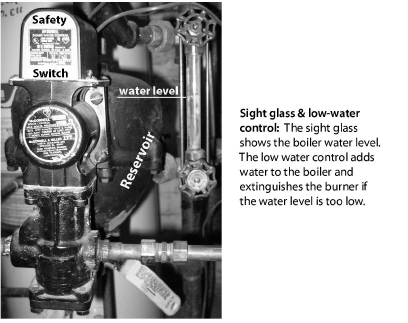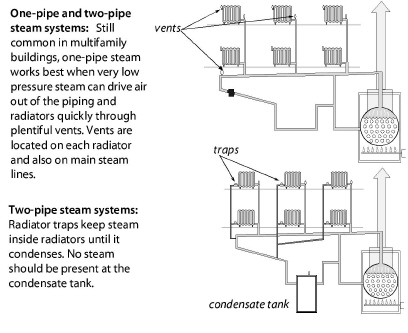
8.18 Steam Heating and Distribution
Steam heating is less efficient than hot-water heating because steam requires higher temperatures than hot water. For single-family homes, consider replacing a steam heating system with a hot-water or forced-air system. Multifamily buildings, especially multi-story buildings, may have little choice but to continue with steam because of the high cost of switching systems.
Note: You can recognize a steam boiler by its sight glass, which indicates the boiler’s water level. Notice that the water doesn’t completely fill the boiler, but instead allows a space for the steam to form above the boiler’s water level.
If the steam-heating system remains, operate it at the lowest steam pressure that heats the building adequately. Two psi on the boiler-pressure gauge is a practical limit for many systems although some systems can operate at pressures down to a few ounces per square inch of pressure. Traps and air vents are crucial to operating at a low steam pressure. Electric vent dampers reduce off-cycle losses for both gas- and oil-fired systems.

8.18.1 Steam System Maintenance
Do these safety and maintenance tasks on steam systems.
ü Verify that steam boilers have functioning high-pressure limits and low-water cut-off controls.
ü Verify the function of the low-water cutoff by flushing the low-water cutoff with the burner operating. Combustion should stop when the water level in the boiler drops below the level of the float. If combustion continues, repair or replace the low-water cutoff.
ü Verify that flush valves on low-water cutoffs are operable and don’t leak water.
ü Ask owner about instituting a schedule of blow-down and chemical-level checks.
ü Specify that technicians drain mud legs on return piping.
8.18.2 Steam System Energy Conservation
Specify the following efficiency checks and improvements for steam systems.
One-Pipe Steam
ü Verify that high-pressure limit control is set at or below 1 (one) psi or as low as acceptable in providing heat to the far ends of the building.
ü Verify that steam reaches all radiators during every steam cycle. Steam need not fill radiators on every cycle. In mild weather, steam partly fills radiators before the boiler cycles off.
ü Radiator air vents should be open to release air while the system is filling with steam, then closed when steam reaches the vents. Replace malfunctioning radiator air vents as necessary. However, don’t over-vent radiators because this can cause water hammer.
ü Verify air vents function and that all steam radiators receive steam during every cycle. Unplug air vents or replace malfunctioning vents as necessary. Add vents to steam lines and radiators as needed to get steam to all the registers.
Two-Pipe Steam
ü When you can gain access to all the system’s steam traps, repair leaking steam traps or replace them. All failed traps should be replaced at the same time to prevent new traps failing because of water hammer from steam leakage through neighboring failed traps. The only 100% reliable way to test a steam trap is to connect it to a test apparatus and see if it allows steam to pass. However if you have an accurate thermometer, the temperature on the radiator side of a functioning trap should be more than 215°F and the temperature on the return side of that trap should be less than 205°F when steam is in the radiator.

ü When you can’t gain access to all the system’s steam traps at the same time, consider abandoning failed steam traps and installing radiator-inlet orifices in two-pipe steam radiators. The orifices limit steam flow to an amount that can condense within the radiator. Orifices can also reduce steam delivery to oversized radiators by 20% or a little more.
ü Consider controlling radiators with thermostatic radiator valves (TRVs) except for radiators in the coolest rooms. TRVs can be used with systems equipped with either traps or orifices. For effective temperature control, the thermostatic element of the TRVs must be located in the path of air moving toward the radiator or convector. TRVs are available with sensors located remotely from the valve, which solves the problem of a valve located where the radiator heats a valve-mounted sensor, fooling it into closing.
ü Inspect return lines and condensate receiver for steam coming back to the boiler. Check radiator and main line traps.
ü Check steam traps with a digital thermometer or listening device to detect any steam escaping from radiators through the condensate return. Replace leaking steam traps or their thermostatic elements.
ü Consider installing remote sensing thermostats that vary cycle length according to outdoor temperature and include night-setback capability.

ü Repair leaks on the steam supply piping or on condensate return piping.
ü Consider a flame-retention burner and electric vent damper as retrofits for steam boilers.
ü Clean fire side of heat exchanger of noticeable dirt.
ü All steam piping that passes through unconditioned areas should be insulated to at least R-3 with fiberglass or specially designed foam pipe insulation rated for steam piping.